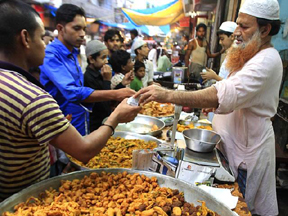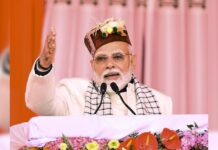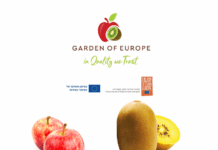 NEW DELHI: From tamarind water phuchkas selling on the dingy lanes of North Kolkata and Jaipur’s famous daal-baati churma, to Old Delhi’s spicy aloo chaat and Lucknow’s wide range of kebabs, the best of India’s street food features in a new book that takes the readers on a virtual food hunt through every nook and corner of the country.
NEW DELHI: From tamarind water phuchkas selling on the dingy lanes of North Kolkata and Jaipur’s famous daal-baati churma, to Old Delhi’s spicy aloo chaat and Lucknow’s wide range of kebabs, the best of India’s street food features in a new book that takes the readers on a virtual food hunt through every nook and corner of the country.
Titled ‘The Travelling Belly’ the book penned by food blogger Kalyan Karmakar is a delectable journey across 11 Indian cities, as the writer highlights the typical snacks of different regions, often giving an insight into the preferred taste palette of the locals, the popular cuisines in the area and sometimes also the spices used to get that characteristic flavor.
Having grown up in Kolkata and lived in Mumbai for several years now, it was only natural that the author would offer an extensive list of munchies from these two cities.
Karmakar’s book is only another addition to the glorious legacies of Mishti Doi (sweet curd) from Bhim Chandra Nag, K C Das’ roshogollas and sondesh, who have been already extensively written about for being the pioneers in making the beloved sweet treats from eastern India.
The city of joy also has enough tablespoons of spice to balance the sweetness out with Maharani’s “crisp freshly fried kochuri with an aloo curry”.
From Mumbai, he has written about the more famous Leopold Cafe, Cafe Churchill and Cafe Mondegar, but his love for Iranian restaurants strewn across the city comes across as heartfelt.
‘Yazdani Bakery and Restaurant’, which he says “is not a restaurant, but a bakery” because “they make their own bread”.
The ‘bun maska’ or ‘brun pav’ is one of the hot selling items at the eatery.
“Maska means butter specifically, Amul (salted) butter.
This is the answer to all of life’s problems, according to most Iranis. And the bun pav is soft, and brun is crusty,” Karmakar writes in the book.
However, despite having written about a variety of quick foods from across the country, what holds back the book is a lack of a sense exploration. Having undertaken the journey based on the suggestions of his Twitter followers, friends and colleagues, Karmakar has ended up writing about already famous eateries, without featuring any stall or food item that he might have come across on his own.
The choice is also not defined by the quality of food that is offered but largely because of the restaurants’ decades-old existence.
From the north the blogger has written about the ‘sweet and sour’ tidbits from Delhi and Lucknow, best known as ‘chaats’.
“Chaat was invented when the Mughal rulers of Delhi wanted a dish that people could have during the monsoon months,” Karmakar quotes Chef Manjit Gill of ITC Hotel Group from one of their conversations.
In Lucknow, his stop was the Dixit Chaat House in Chowk area, where the 40-year-old establishment run by the third generation of owners, sells their widely famous ‘dahi aloo tikki’ and ‘matar chaat’, the latter being a city special. PTI MAH TRS (MORE)
Made with boiled gram pulses cooked and mashed with spices and then drenched in lime juice, the dish is served with crushed flakes of the deep-fried crust of the khasta kachori.
In the Capital city, Karmakar tried chaat at Hiralal near Chawri Bazaar Metro station, where he nibbled on the aloo chaat, made out of “cubed boiled potatoes put into hot oil till perfectly fried, then tossed in spicy chaat masala and placed on our plates with some toothpicks to pick them up with”.
Kachoris and samosas took centre-stage in Rajasthan, where the author visited the Rawat Mishthan Bhandar near Jaipur railway station, well known for its pyaaz kachori.
Country’s technology hub Bengaluru also finds place in ‘The Travelling Belly’ as Karmakar visited Veena Stores, famous for its ‘idli’ and ‘vada’, although he found the ‘puliyogare’ more enticing.
“Puliyogare is tamarind-flavored rice in which the rice is light and airy, the tamarind juice gives it a lovely and fresh tanginess reminiscent of the Kolkata jhalmuri and the peanuts interspersed in it give it a nutty taste and texture which contrasts with the rice,” writes Karmakar.
Other dishes that find mention in Karmakar’s food trail include the biryanis of Hyderabad and ‘lagan no bhonu’, the wedding feast of Parsis in Mumbai among others.–PTI






